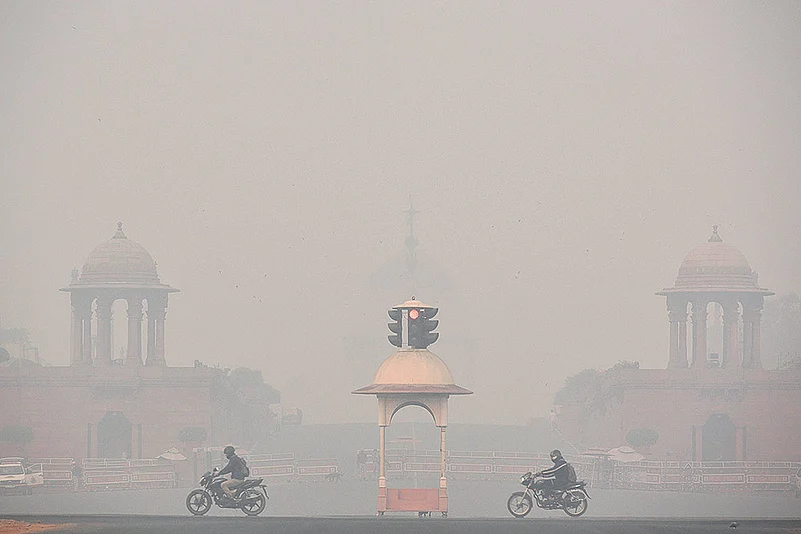Hold your breath, if you can, although the chances are that you are still more likely to die. According the Greenpeace India’s list (2019) of the worst air-polluted cities, 15 of the top 20 are in India. Worse, Delhi, which is the most polluted capital in the world, ranks 11 on the list, is surrounded by Gurugram (No. 1), Ghaziabad (No. 2), Faridabad (No. 4), and NOIDA (No. 6). Bhiwadi (No. 5) is just 80 km from the Indian capital. Hence, the so-called cluster of National Capital Territory, or National Capital Region, whatever you term it, is the most air-polluted area in the world.
Last November, the day after Diwali, the pollution level in Delhi was 999 (as per the official Air Quality Index), or 20 times the normal of 50. This was despite the Supreme Court ban on firecrackers. Visitors to the capital, and even domestic travellers from other cities, find it hard to breathe, and immediately suffer from throat and lung infections. Facemasks have become a common feature in the city, and its peripheral regions. With apologies to Vicki Kralapp, one can say, “With every breath, and every move, I take you in, and you make me yours. You are, the very air I don’t need, my very life, my silent prayers, as I slowly die.”
Air pollution, as one is rarely aware, is agnostic towards developed and developing nations, rich and poor, urbanites and rural dwellers, and adults and children. It kills millions of people across the world, although some areas are particularly prone to its devastating impacts. According to the World Health Organisation, it is the “world’s largest environmental health risk, and among the largest global health risks.” A recent UNICEF report claims, “Around 300 million children currently live in areas where the air is toxic — exceeding international limits by at least six times.”
Yet another myth about air pollution is that it is entirely man-made. When we think of the toxic air, we visualise images related to fossil fuels (coal and diesel), industrial manufacturing, waste burning, dust, exhaust from vehicles, and smoke and black carbon from the burning of crop stubbles and forests. But, as the UNICEF report states, “There are also a variety of natural causes, including volcano eruptions… and dust storms….” More importantly, since these pollutants can be dispersed and transferred rather quickly by wind and weather conditions, everyone within larger vicinity is at a considerable risk.

In a similar vein, air pollution is not merely linked to the outdoors; it is as much of a problem within the closed confines of the households. When we confront it, it is generally through visuals of the outside air, dark and grayish with a pungent and stark mix of smog, dust, and minute particles that we do not even feel. However, “burning of solid fuels for household cooking, heating, and lighting is major cause of household, or indoor, air pollution.” In fact, this puts nearly three billion people at risk of ill-health and early death. According to some reports, indoor pollution kills more children globally than outdoor ones.
What is important to note, however, is that we can control air pollution if we wish to. Take the example of the cities in China, which were the most polluted ones a few years ago.
According to a recent media report, “The report (Greenpeace India; 2019) found that average concentrations of pollutants fell in Chinese cities by 12% from 2017 to 2018, while the capital Beijing has fallen out of the top 100 polluted cities following concerted efforts to get air pollution under control.” It added, “China’s most polluted city in 2018… was Hotan…. Baoding, which once ranked among the worst in the country, is now at number 33.”
***
Lethal Air Pollutants
- PM(10) are particulates that are one-seventh the diameter of a human air. They are major components of indoor pollution and forest fires. They include black carbon and dust, among other elements. They block and inflame nasal and bronchial passages.
- PM(2.5) are considered more dangerous because of their fine nature, one-thirtieth the diameter of human hair. They permeate deep inside the lungs, and even into the bloodstreams. They result from fossil fuels, vehicle exhaust, power plants, and natural causes like wind dust and volcanic eruptions.
- Ground-level Ozone is formed during warm, sunny days, particularly in the afternoon, and is a powerful respiratory irritant.
- Carbon monoxide is a colourless and odourless gas, generally produced by vehicles. Very high levels ofexposure can result in unconsciousness and even death.
- Nitrogen oxides result from fossil fuel combustion. While they occur on roads and closer to factories, they are also produced in households where gas is used for cooking.
















